Louise Bourgsoie Drawing of Man With Glasses
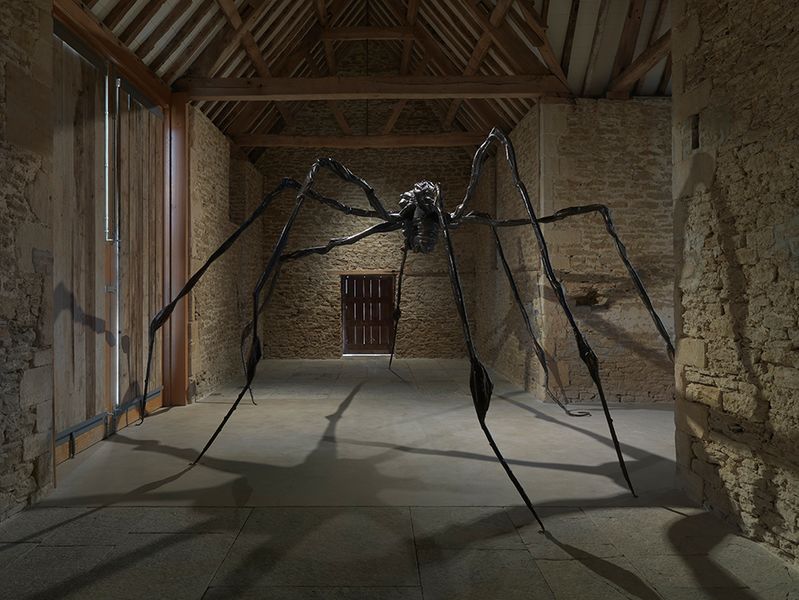
Installation view, 'Louise Bourgeois. Turning Inwards', Hauser & Wirth Somerset, 2016. Photo: Ken Adlard
Louise Bourgeois: Turning Inwards
This resource has been produced to accompany the exhibition, 'Louise Bourgeois. Turning Inwards', at Hauser & Wirth Somerset.
This resource has been produced to accompany the exhibition, 'Louise Bourgeois. Turning Inwards', at Hauser & Wirth Somerset. It is designed for teachers and students, to be used alongside their visit to the exhibition. It provides an introduction to the artist Louise Bourgeois, identifies the key themes of her work and makes reference to the historical and theoretical contexts in which her practice can be understood. It offers activities, which can be carried out during a visit to the gallery and topics for discussion and additional research.
The exhibition features a body of painting, print, drawing and sculpture, most of which has been curated in relation to the existing farm buildings and new architecture at Hauser & Wirth Somerset, creating a new environment and experience of Louise Bourgeois's work in Somerset.
Louise Joséphine Bourgeois was born in Paris on Christmas Day in 1911. She was one of three children; their parents ran an Aubusson tapestry restoration business and a tapestry gallery in Paris. As a child she regularly helped with the family business, and by the time she was 12 years old, she was regularly using her drawing to help repair missing fragments of damaged tapestries; apparently she was an expert at drawing hands and feet.
Louise Bourgeois was well educated; she studied Mathematics at the Sorbonne in Paris in the early 1930s. Around 1933, she decided to focus on art, at which point she began working at other artists' studios, including Fernand Léger's. In 1938, she opened her own gallery in a space partitioned off from her father's tapestry gallery where she showed the work of artists such as Eugène Delacroix, Henri Matisse and Suzanne Valadon. It was here that she met Robert Goldwater who she married and soon after had three sons. Goldwater was a prominent art historian and an influential teacher who specialised in African Art. He died in 1973 at the premature age of 66.
After her emigration to New York in 1938, Bourgeois enrolled in the Art Students League and studied painting for two years. Between 1977 and 2002, Bourgeois was the recipient of 7 Honorary Doctorates of Fine Arts from institutions such as Yale University and the Art Institute of Chicago
Save Save
Save Save

Photo: Nanda Lanfranco
Whilst living in New York in the 1940s Louise Bourgeois had the opportunity to meet many of the key figures of twentieth century art: academics such as Clement Greenberg and Alfred H. Barr, Jr., art dealers such as Peggy Guggenheim, and influential artists Mark Rothko, Franz Kline, Willem de Kooning and John Cage. By the end of the 1940s she began working in sculpture as well as continuing her drawing and painting.
From this period onwards, Bourgeois raised her family and worked as an artist. She was included in many group shows and held solo exhibitions; her work was also collected by major museums including the Museum of Modern Art in New York.
While her career as an artist developed in New York, Louise Bourgeois also began teaching at Brooklyn College and the Pratt Institute. She also became involved in demonstrations and exhibitions associated with feminism in the 1970s. She was the first female artist to be the subject of a large-scale career retrospective at the Museum of Modern Art, which took place in 1982.
Despite her active career, Louise Bourgeois suffered with depression and high anxiety. She looked to psychoanalysis to help her deal with her emotions and often took to drawing when she could not sleep. All of her artwork relates to her life and in particular her relationship with other people. Her favourite colour was the blue of the sky.
In 2000 when Tate Modern first opened, Louise Bourgeois was awarded the very first commission for the Turbine Hall; she made 'Maman' (1999), a huge sculpture of a spider constructed from steel and marble, and three steel towers called 'I Do, I Undo, I Redo'.
Louise Bourgeois's artistic career spanned seven decades – a period of time that saw the rise of Surrealism, Abstraction, Minimalism and many other important artistic movements. However, Bourgeois's career was very single-minded and was never directly tied to current art historical trends. Like the title of her work, 'I Do, I Undo, I Redo', she spent her life reflecting on and contributing to her own personal relationship with art.

Working Methods
Louise Bourgeois is best known for making artwork that is personal and narrative. She employed a wide variety of working methods and materials in her work, working across the genres of drawing, printmaking, painting and sculpture and was an early champion of installation art.
The title of this exhibition 'Turning Inwards' includes a series of etchings, made between 2006 and 2010 with the publisher Osiris. Abstract motifs are portrayed in these works through natural forms, see 'The Smell of Eucalyptus (#1)' (2006) or the figure, with hanging and twisted intestines, see 'Knots' (2006). Sometimes she creates movement and sometimes constriction and physical pain. Her preoccupation is with the natural world as well as the human body. Her prints are life size and were made in the most traditional way. She drew these images directly onto the copper plates.

Louise Bourgeois, 'The Smell of Eucalyptus (#1)', 2006. Photo: Ben Shiff
The sense of personal reflection that we find throughout her body of work is supported by the fact that ever since childhood she kept diaries and made drawings. She also loved books, having a large collection in her home and also making her own 'Artist Books'. Despite being French and growing up in Paris, the majority of her writing is in English. She kept different types of diaries: a traditional written diary, a drawing diary and a spoken diary which recorded her speaking. Each of her diaries is a collection of highly personal memories and ideas, the content is reflected in her drawing and paintings.
Early in her career Louise Bourgeois made paintings and mixed media drawings that were relatively modest in scale compared to the large bold paintings of the Abstract Expressionists or the complex and imaginary paintings of the Surrealists with whom she was familiar. The subjects of her paintings were often drawn from architecture and the human form; she created images of domestic environments where figures and buildings were intertwined. In this exhibition, we see how she continued to merge subjects; the bronze sculpture, 'Topiary' (2005), shows a figure that grows into a seed head.
Louise Bourgeois started to work in three dimensions in the mid 1940s. Whilst the tradition of drawing and painting is based on illusionary space, sculpture allowed her to make work that created a different type of engagement with its viewer. She also loved the physical aspect of making sculpture, of carving and cutting.
Her work remained influenced by the landscape and the body as well as iconography of New York City. By the 1950s, the trends in modern art began to develop a minimal approach, but unlike sculptors such as David Smith,
Bourgeois began to think about her sculpture as installations, making work that the viewer had to physically navigate, with the space itself becoming part of the sculpture. She used body and architecture, flesh and landscape as media in her work, as expressed through materials like latex, resin, wax, hemp cloth, needles and pins.
This mixture of media is seen in the wall sculpture, 'My Blue Sky' (1989 – 2003) in which a mountainous landscape dissolves into the curves of the feminine body as they float up towards the loosely rendered blue sky – a colour that represented, for Bourgeois, peace, meditation and escape. She loved the New York sky – so blue and clear in contrast to the grey of Paris where she grew up.1 The window frame in this work was salvaged from the basement of her home. Her sculptural transformation of domestic objects reinforces her personal relationship with all of the materials that she employs. It was created in the latter part of her life when she had confined herself to the interior of her house, the window represents a lifeline to the outside world.
Save Save
Save Save
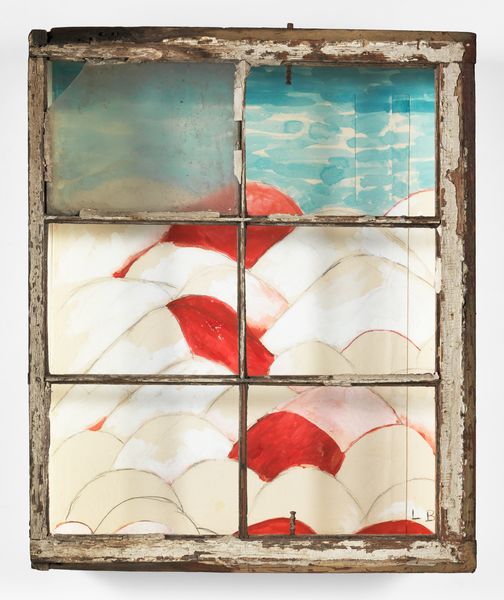
Louise Bourgeois, 'My Blue Sky', 1989-2003. Photo: Christopher Burke
'Untitled' (2005) is a trio of totemic structures encased in a glass vitrine. It is constructed from stacked parts, distinguishable in shape, material and colour. 'Untitled' recalls Louise Bourgeois's distinct segmented Personage sculptures from the early 1950s resembling the postures of human figures and urban structures, such as skyscrapers. The Personages served as physical representation of the friends and family Bourgeois had left behind in France, as well as highlighting her continued interest in architecture.
However, she also maintained an interest in traditional sculpture like carving – mostly seen as a male tradition. This coincided with the rapidly developing feminist cause during her early time in New York. Through the gallery window, looking onto Oudolf Field, the visitor sees Bourgeois's black granite 'Eye Benches II' (1996 – 1997). Meanwhile, in the gallery space, 'I See You!!!' (2007) is a surreal etching in which the disembodied outline of a head and torso is filled with an abundance of illustrated eyes.
- Louise Bourgeois, 'the puritan' (1990 – 1997), published by Osiris, New York.

Louise Bourgeois, 'I See You!!!', 2007. Photo: Ben Shiff
Themes
Domesticity
Louise Bourgeois's journey from her childhood in Paris to her married adult life in New York coincided with the Second World War. During this time many artists left Europe for America, with most artists pursuing a clear Modernist route in movements such as Abstract Expressionism and Minimalism. However, Bourgeois made this relocation a theme of her work, a narrative which through the continued depiction of bodies and architecture reinforces her ongoing interest in her own personal journey into childhood and adulthood.
Architecture and the Body
From her early 2D works on paper depicting a female figure trapped inside a house to her room-like installations known as Cells, which often contain domestic items such as tools and furniture, architecture and the body has remained an important part of her oeuvre. In 'My Secret Life' (2007) the artist employs a figurative vocabulary drawn from the human body, it looks like a totemic column of breasts and phalluses, which pile up along the central axis of the composition. All of the prints in the exhibition have a very organic, biological, reproductive feel to them; they draw attention to the secret or hidden parts of the body.
Colour
Themes of sexuality, human relationships and the body reach a climax in the final room of the exhibition. Bourgeois was a dedicated writer. In this gallery, the viewer is presented with a series of works she emblazoned with emotive knots running vertiginously up the paper. While these meandering compositions bear resemblance to blood vessels, they also appear as rippling streams in an abstract landscape. Bourgeois said that the colour blue was her colour, which she felt words and phrases. Here she reveals the intensity of her inner turmoil. The intensity of the red in these three works are reflected in quote from her diaries: 'Red is the colour of blood. Red is the colour of insistence.'2
In the Rhoades gallery the colour blue is as though it has been dropped from the sky. Three blue gouache enhanced etchings, all entitled 'Look Up!' (2009 – 2010), depict tangled, vein-like transported her from the drabness of everyday to the freedom of being able to say what you like and what you don't like. Blue, 'Represents peace, meditation and escape'.3
Childhood and Motherhood
Even as a young child, Louise Bourgeois made drawings, either for pleasure or as work for her parents' tapestry business. The memories of her childhood stayed with her for the rest of her life.
It was Joséphine, her mother, who encouraged Bourgeois to draw and who involved her in the tapestry business. Bourgeois considered her mother to be intellectual and methodical; the continued motif of the spider in her work from 1994 and until her death in 2010 often represents her mother. 'Spider' (1996) is one of a series of spider sculptures in steel and bronze, although she originally made two drawings of spiders in 1947. The notion of a spider that spins and weaves its web makes direct reference to the tapestry business that her parents ran. It can also be seen as a metaphor for her mother, who repairs things. In the exhibition, the Threshing Barn contains a spider – the gallery is dark and a little eerie, the lighting makes the viewer feel somewhat uncomfortable and claustrophobic, possibly mimicking the feelings of the artist.
Many of Louise Bourgeois's late red gouache drawings explore the themes that had preoccupied her for many years: birth, reproduction, motherhood, sexuality and human relationships. Despite her old age, Bourgeois still reflected on both the experience of being a child herself and also of giving birth to her own children.
Trauma and Anxiety
Many of Louise Bourgeois's anxieties stem from her childhood; she was exposed to the clashes between her parents who had very different personalities and attitudes. Her father was unfaithful to her mother and even brought his mistresses to the family home. Her mother suffered from illness and died when Bourgeois was 22. She loved and cared for her mother and clearly missed them both, as well as her life in France once she moved to New York.
Despite her occasionally traumatic childhood, Louise Bourgeois's drawings and prints in this exhibition are for the most part, filled with calm. She often used a limited palette and repetition, the simple lines and limited colours appear relaxing. She said, 'The repetitive notion of a line, to create an object […] the endless repetition of waves, rocking a person to sleep, cleaning someone you like, an endless gesture of love'4
2. Louise Bourgeois interview with Cecilia Bloomberg, 16 Oct 1998 in Francis Morris, 'Louise Bourgeois', Tate Publishing, London / UK, 2007, p. 83
3. Meyer-Thoss 1992, in Ed. Francis Morris, 'Louise Bourgeois', Tate Publishing, London / UK, 2007, 68
4. Gorovoy & Cheim 1988, in Jerry Gorovoy and John Cheim, 'Louise Bourgeois Drawings', Robert Miller Gallery NY/Daniel Lelong Paris, 1998 p.138)
Contexts
History
Louise Bourgeois's artistic practice spanned the best part of a century. At a time when art world thinking was dominated with formal issues with the development of well-known avant-garde movements: Surrealism, Abstract Expressionism, Pop, Minimal and Conceptual Art, Bourgeois remained idiosyncratic.
New York City between the 1960s and the 1980s was a time of great experimentation in art. Bourgeois can be seen as post-minimal in her approach, she employed a wide range of materials and repetition but at the same time her work is natural and organic and is in contrast to the ordered geometric structure of minimal artists like Donald Judd.
Feminism
A generation of women artists, which emerged in America in the 1970s, became known as Feminist Artists – this included Judy Chicago and Mary Kelly. These artists made art that commented on personal and shared identity within a broader political context. For example, Judy Chicago employed the subject of the female form and its sexuality as her themes and used ways of working such as stitch or ceramics, which were traditionally associated with women's work in order to challenge the role of women in art.
However, artists like Louise Bourgeois had a different approach, similar to the artists Agnes Martin and Eva Hesse from the same generation; some female artists were not driven by the political but made work that drew on their experiences of gender and sexuality, naturally engaging with women's issues.
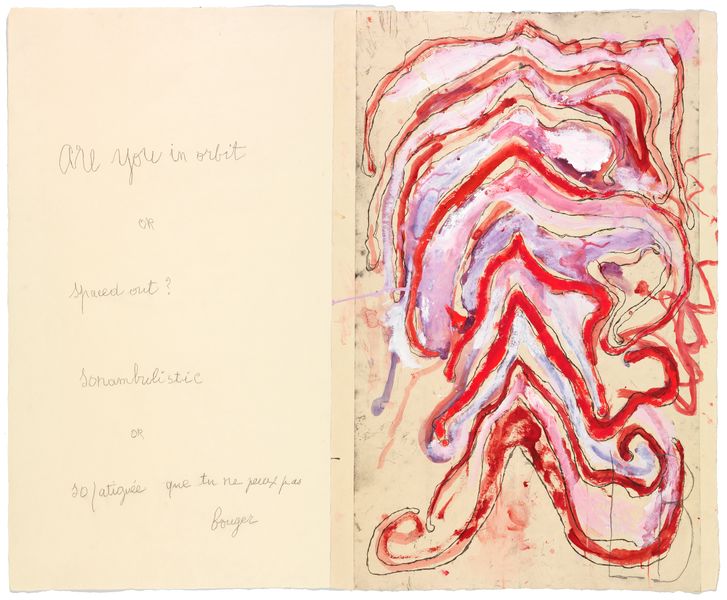
Louise Bourgeois, 'Are You In Orbit?', 2008. Photo: Ben Shiff
Psychoanalysis
Bourgeois saw a psychoanalyst for many years; she is often described as the mother of confessional art, art that employs autobiography and personal symbolism like the contemporary artist, Tracey Emin (who often cites Bourgeois as a huge influence on her work).
In the mid-1990s, Louise Bourgeois began to use old clothes she had kept from the past, either her own or those of her mother. These treasured items were the raw materials in many of her works, from sculptures to cloth books to her 'Fabric Drawings'. This made a direct link to the experience of sewing with her mother when she was a child and for her family's tapestry restoration business and conveys how she was interested in psychoanalytical interpretations of repair.
One of her fabric books, 'Ode à La Bièvre', serves as a visual poem that makes reference to the river near her family home. The river water contained the tannin that was needed for the dying of tapestries. Water can also be used as a symbol for the unconscious mind, and a fluid line representing water can be seen in many of Louise Bourgeois' drawings.
Louise Bourgeois said 'I need my memories: They are my documents.'5 Throughout her career, Bourgeois used her life 's experiences, in particular her relationships with others, as fuel for her art.
5. Stitched onto bed coverings inside Louise Bourgeois's 'Cell 1' (1991)
Save Save
Suggested Activities
Make three drawings of the Spider
- Wearing a blindfold draw from your partner's description.
- A formal and mathematical drawing, think of ays to do this, e.g. using a viewfinder, measuring, using only straight lines etc.
- A continuous line drawing (do not take your pencil off the paper).
Truthful Interpretations
Louise Bourgeois kept lots of diaries and used words to record her feelings and emotions. Imagine that the spider could talk, use speech bubbles to show what it would say.
Louise Bourgeois used line to make very emotive drawings; how can you put emotion into your drawing/how can marks or shapes suggest different feelings?
Although there are lots of 2D works in this exhibition, think about her sculptures; choose one of the drawings to turn into a 3D form. You may use pipe cleaners, clay, string, wire or card. Try to copy the abstract shapes that you see in the drawing. What does it become? is your sculpture like a natural form, e.g. a plant or is it like architecture e.g. a house?
In small groups or pairs, choose one artwork and think of five words that best describe it. Share your five words with the rest of the groups and see if you can tell which artwork each group was looking at.
Make an acrostic poem about Louise Bourgeois using one of your words from the previous exercise.
Discussion Questions
- Do you think that Louise Bourgeois was a Feminist? Discuss reasons for your answer.
- Do you think that all art is autobiographical? Discuss your thoughts.
- What emotions do you feel when you look at Louise Bourgeois's work? How do artists evoke emotion? Think of examples of different approaches.
- Discuss metaphors that you could use to describe your own life so far.
- Does the art world still give priority to painting and sculpture over domestic arts (sewing and printmaking for example)? Discuss this in your group.
Bibliography and Supplementary Research
'Louise Bourgeois Drawings', Gorovoy and Cheim (eds), Robert Milner Gallery, New York, 1998
'Structures of Existence: The Cells', Munich/ DE: Haus der Kunst; London/UK: Prestel, 2015
'Artist Rooms: Louise Bourgeois, A Woman without Secrets', ARTISTS ROOMS exhibition at Scottish National Gallery of Modern Art, Edinburgh, 26 October 2013 – 18 May 2014
Louise Bourgeois. L'araignée et les tapisseries', exhibition at Hauser & Wirth Zürich, 15 June – 26 July 2014
'Insomnia in the work of Louise Bourgeois', Fruitmarket Gallery, Edinburgh/UK, 'Louise Bourgeois. I Give Everything Away', 26 October 2013 – 23 February 2014
Louise Bourgeois: Alone and Together, Faurschou Foundation, 2014 (exhibition curated by Jerry Gorovoy).
Louise Bourgeois', Phaidon Press Limited, 2003
'Louise Bourgeois', Edited by Francis Morris, Tate Publishing, 2007
'Cloth Lullaby: The Woven Life Of Louise Bourgeois', Amy Novesky & Isabelle Arsenault,
Abrams, 2016
www.tate.org.uk
Related Artists and Movements to consider
Artists
Eva Hesse
Marcel Duchamp
Tracy Emin
Constantin Brancusi
Alberto Giacometti
David Smith
Movements
Surrealism
Abstract Expressionism
Conceptual Art
Feminism
Post Minimalism
Glossary
Abstract Expressionism
Can be crudely split into two areas: colour field painters and action painters. This includes the work of Mark Rothko, Barnett Newman and Jackson Pollock.
Existentialism
Existentialism is a philosophical movement; it focuses on individual existence, freedom and choice.
Metaphor
A metaphor is a thing or object, which is employed to represent or symbolise something else. In her adult life Louise Bourgeois often discussed sewing as a metaphor for the process of repair in relationships, and she held the tools of the restorer and seamstress in high regard. Shealso used the spider to represent the characteristics of her mother.
Minimalism
Minimalism is the name given to art that developed in America in the 1960s that involved art made from simple geometric shapes like squares and triangles, art was made out of the sparsest of materials with the least intervention from the artists. The intention was to make something as abstract as possible so that it hadit's own reality rather than associating itself with things from the real world.
Another artists to consider is Agnes Martin. Learn more about her here
Feminist Movement
Since the 1960s the feminist art movement and feminist theory have developed to reflect women's lives and experiences. Louise Bourgeois' work deals with a range of politics, drawing attention to positions of power in relationships; feminism is one way of addressing this.
Another artist to consider is Ida Applebroog. Learn more about her here
Patriarchal Order
The order of a social society, which is based on the male having control or primary power, for example a male politician or father as the head of a family.
Post Minimal
Postminimal art uses minimalism as a reference point. It is more an artistic tendency than a particular movement. Postminimalist artworks are usually everyday objects and they use simple materials. Another artist to consider is Eva Hesse. Learn more about her here
Postmodern
Postmodernist is a way of describing cultural movements and styles since the 1960s. It is often described as demonstrating a blurring of the boundaries between high and low culture. It does not recognise a single authority, style or method of working.
Psychoanalysis
Psychoanalysis was founded by Sigmund Freud (1856 – 1939). Freud believed that people could be cured by making conscious their unconscious thoughts and motivations, thus gaining insight. The aim of psychoanalysis therapy is to release repressed emotions and experiences, i.e. make the unconscious conscious.
Another artist to consider is Pipilotti Rist. Learn more about her here
Surrealism
Surrealism was a movement, which began in the 1920s when writers and artists began to experiment with ways of unleashing the subconscious imagination.

Education Guide
As many of us continue to work or learn from home, our artists have created a series of downloadable coloring pages...
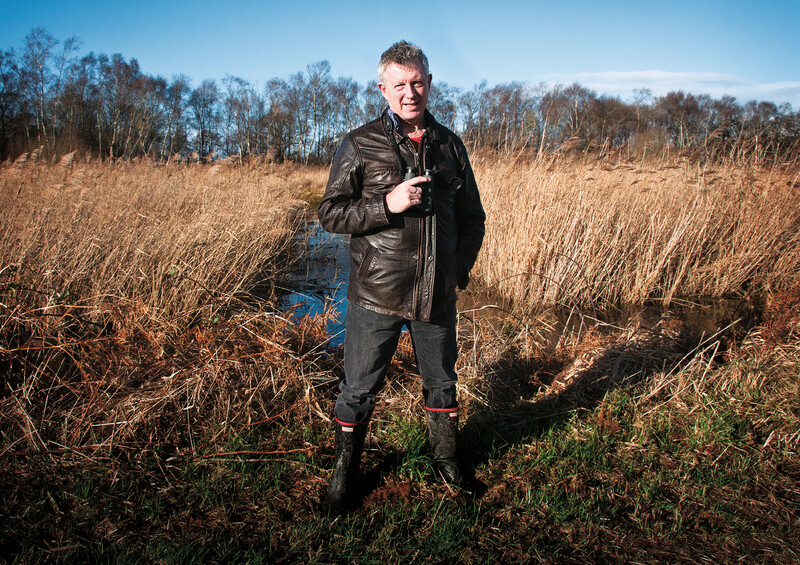
Audio
'We are nature, we are part of nature, we are tied with nature. And when we go, nature will still be there. It might...

Education Guide
Following an initial debut at Hauser & Wirth New York in late 2019, 'To Exalt the Ephemeral: Alina Szapocznikow,...
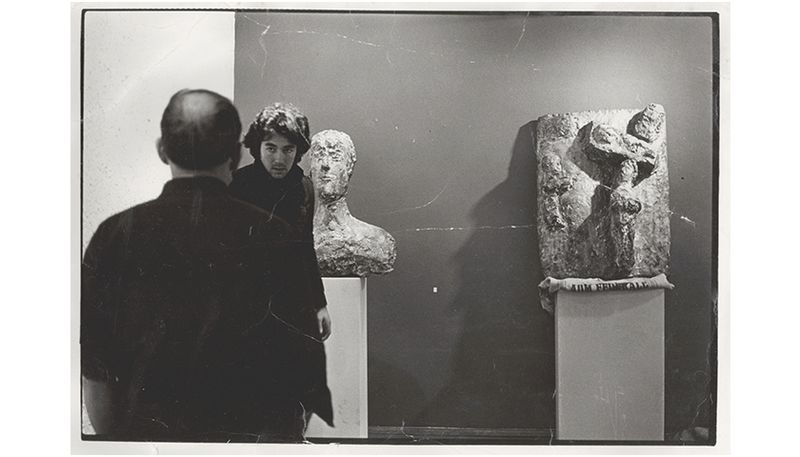
Education Guide
This resource has been produced to accompany the exhibition, 'Josephsohn / Märkli. A Conjunction', at Hauser & Wirth...

Audio
This resource has been produced to accompany the exhibition, 'Louise Bourgeois. Turning Inwards', at Hauser & Wirth...

Education Guide
This resource has been produced to accompany the exhibition, 'Elisabeth Frink, Transformation' at Hauser & Wirth...
Louise Bourgsoie Drawing of Man With Glasses
Source: https://www.hauserwirth.com/resources/2694-louise-bourgeois-turning-inwards
0 Response to "Louise Bourgsoie Drawing of Man With Glasses"
Post a Comment